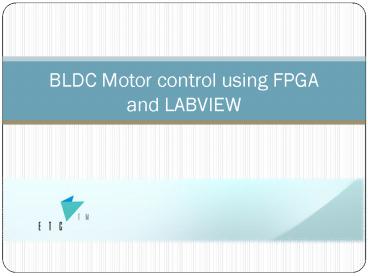BLDC Motor control using FPGA and LABVIEW - PowerPoint PPT Presentation
1 / 11
Title:
BLDC Motor control using FPGA and LABVIEW
Description:
BLDC Motor control using FPGA and LABVIEW Motivation */12 Motors a basic component of our lives FPGA challenging but extremely flexible LabVIEW powerful ... – PowerPoint PPT presentation
Number of Views:292
Avg rating:3.0/5.0
Title: BLDC Motor control using FPGA and LABVIEW
1
BLDC Motor control using FPGA and LABVIEW
2
Motivation
- Motors a basic component of our lives
- FPGA challenging but extremely flexible
- LabVIEW powerful and intuitive development
platform - Wii Remote adds a much-needed fun factor and
freedom of control to the project
3
The Hardware Platform
- Nintendo Wii Remote
- Hurst BLDC motor
- Motor Driver (partial schematic)
- Spartan 3E Starter Kit
4
The Software Platform
- LabVIEW 2009 provides a comprehensive development
environment allowing access to all the resources
necessary in order to implement the present
project, either in its standard form or through
one of its modules - FPGA Module
- PID Module
5
The Software Platform
- LabVIEW greatly shortens development time
6
Full project chain
- The WiiMote communicates with the laptop through
Bluetooth - LabVIEW uses a .NET framework DLL in order to
initialize the remote and interpret the data
received
7
Full project chain
- LabVIEW FPGA module manages the programming of
the FPGA, as well as communication between the
host and target VIs through USB
8
Full project chain
- The FPGA generates a PWM signal to drive the
motor - The Hall signals generated on the BLDC side are
read by the FPGA, determining correct energizing
of driver transistors and motor speed for PID
loop adjustments - PID feedback loop is implemented on the FPGA
Driver
9
Interface
- Straightforward
- Intuitive
- Easy to use
10
Some results
11
Observations Conclusions
- Hall sensors are really noisy
- WiiMote accelerometer is very sensitive
- PID loop manual tuning is difficult and may take
long
- WiiMote control is very intuitive, extra visual
feedback added by the implemented 3D model - LabVIEW allows for easily interpretable results
- PID response follows the setpoint accurately,
giving no overshoot but a 10 undershoot































